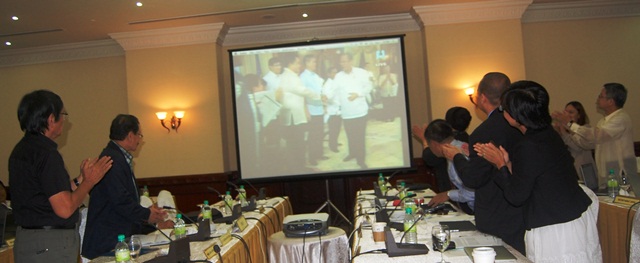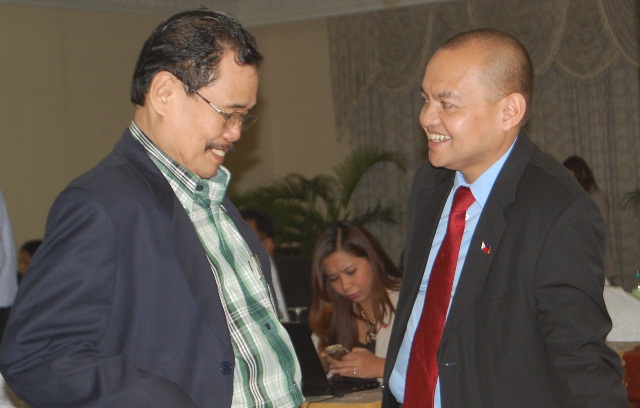KUALA LUMPUR (MindaNews/07 October) — The Bangsamoro is finally, officially recognized by the Philippine government.
After 15 years of peace negotiations, two of that under the Aquino administration, the Philippine government (GPH) and the Moro Islamic Liberation Front (MILF) made history Sunday (October 7) by announcing they have reached a Framework Agreement that would give birth to a new autonomous political entity whose name, President Benigno Simeon Aquino III said, “symbolizes and honors the struggles of our forebears in Mindanao” and “celebrates the history and character of that part of our nation.”
“That name will be Bangsamoro,” Aquino said in a 10-minute speech streamed live from Malacanang into the State Room of the Palace of the Golden Horses hotel where the peace panels watched, broke into cheers (some in tears) and applause ten times and gave him (and for all of them, someone remarked), a standing ovation as he ended his speech, thus: “Finally, we have achieved peace, a peace that will serve as the foundation of our dreams for Bangsamoro, for Mindanao, and for the entire Filipino nation.”
 STANDING OVATION. Members of the MILF peace panel (left) and the government peace panel (right) give President Aquino a standing ovation at the end of his address to the nation streamed live from Malacanang, at the State Room of the Palace of the Golden Horses hotel in Kuala Lumpur where the two panels concluded negotiations on the Framework Agreement. Someone remarked the standing ovation should be for themselves as well. MindaNews photo by Carolyn O. Arguillas
STANDING OVATION. Members of the MILF peace panel (left) and the government peace panel (right) give President Aquino a standing ovation at the end of his address to the nation streamed live from Malacanang, at the State Room of the Palace of the Golden Horses hotel in Kuala Lumpur where the two panels concluded negotiations on the Framework Agreement. Someone remarked the standing ovation should be for themselves as well. MindaNews photo by Carolyn O. Arguillas
Bangsa is a Malay word that means ‘nation.’ The Moro people have long asserted that an injustice has been done to them, that they were a nation long before Spain ceded to the United States through the Treaty of Paris in 1898 what is now the Philippines, including their homeland
The Framework Agreement, Aquino said, “paves the way for a final, enduring peace in Mindanao” as it brings “all former secessionist groups into the fold; no longer does the Moro Islamic Liberation Front aspire for a separate state. This means that hands that once held rifles will be put to use tilling land, selling produce, manning work stations, and opening doorways of opportunity for other citizens.”
The national government will continue exercising exclusive powers of defense and security, foreign policy, monetary policy and coinage, citizenship, and naturalization. “The Constitution and lawful processes shall govern the transition to the Bangsamoro.”
The President said the pact “will ensure that the Philippines remains one nation and one people, with all of our diverse cultures and narratives seeking the common goal. The Filipinos of Bangsamoro, on the other hand, will be assured a fair and equitable share of taxation, revenues, and the fruits of national patrimony. They will enjoy equal protection of laws and access to impartial justice.”
Core territory
The 13-page Framework Agreement provides the roadmap for the Bangsamoro, the new autonomous political entity that would replace the Autonomous Region in Muslim Mindanao (ARMM) which the President in his address to the nation Sunday reiterated to be a “failed experiment.”
The ARMM was inaugurated in 1990 by the President’s mother, Corazon Aquino, who was President from 1986 to 1992.
Contrary to popular belief, the ARMM was not a product of any peace negotiation. The creation of autonomous regions in Muslim Mindanao and the Cordilleras was provided for in the 1987 Constitution whose ratification was boycotted by both the Moro National Liberation Front and MILF.
The Bangsamoro will have, as earlier agreed upon in the April 24 Decision Points on Principles, a “ministerial form” of government.
Its core territory will be the present five-province, two-city Autonomous Region in Muslim Mindanao, the six towns in Lanao del Norte (Baloi, Munai, Nunungan, Pantar, Tagoloan and Tangkal) and the barangays in the towns of Kabacan, Carmen, Aleosan, Pigcawayan, Pikit and Midsayap that voted for inclusion it he 2001 plebiscite; the cities of Cotabato and Isabela in Basilan and all other contiguous areas where there is a resolution of the local government unit or there is a petition of a t least ten per cent of the qualified voters in their area.
The parties will work together to “ensure the widest acceptability of the Bangsamoro Basic Law as drafted by the TransCom and the core areas… through a process of popular ratification among all the Bangsamoro within the areas for their adoption.”
 THE ROAD AHEAD. Mohagher Iqbal, chair of the Moro Islamic Liberation Front peace panel and Marvic Leonen, chair of the government peace panel in a casual conversation inside the State Room of the Palace of the Golden Horses hotel in Kuala Lumpur, while waiting to watch President Aquino’s address to the nation streamed live from Malacanang. The two panels finished their Framework Agreement late Saturday night. MindaNews photo by Carolyn O. Arguillas
THE ROAD AHEAD. Mohagher Iqbal, chair of the Moro Islamic Liberation Front peace panel and Marvic Leonen, chair of the government peace panel in a casual conversation inside the State Room of the Palace of the Golden Horses hotel in Kuala Lumpur, while waiting to watch President Aquino’s address to the nation streamed live from Malacanang. The two panels finished their Framework Agreement late Saturday night. MindaNews photo by Carolyn O. Arguillas
Roadmap, Timeline
Under the Agreement, a Transition Commission (TransCom) that will pave the way for the eventual establishment of the Bangsamoro by 2016 will be created through an Executive Order and supported by Congressional resolutions.
“My administration has pledged to supporting a law that will truly embody the values and aspirations of the people of Bangsamoro. Any proposed law resulting from this framework will be subject to ratification through a plebiscite. Once approved, there will be elections,” the President said.
The TransCom, which will begin operating as soon as the EO and Congressional resolutions are issued, will be composed of 15 members, all of them Bangsamoro — seven named by GPH and eight by the MILF, including the chair.
The TransCom will be “independent from the ARMM and other government agencies” and will be allocated a budget and other resources “for its effective operation.”
The TransCom is tasked to work on the drafting of the Bangsmaoro Basic Law; work on proposals to amend the Constitution “for purposes of accommodating and entrenching in the Constitution the agreements of the Parties whenever necessary without derogating from any prior peace agreements” and to coordinate, when necessary, development programs in the Bangsamoro communities in conjunction with the MILF’s Bangsamoro Development Agency and the Bangsamoro Leadership and Management Institute and other agencies.
ARMM abolition
The draft Bangsamoro Basic Law that the TransCom will submit and which will also provide for the creation of the Bangsamoro Transition Authority (BTA) “shall be certified as an urgent bill by the President.”
The ARMM is “deemed abolished,” upon the promulgation and ratification of the Bangsamoro Basic Law.
The ARMM elections on May 13, 2013 will be the last of that entity
The peace panels will not be disbanded upon signing of the Framework Agreement. They will continue negotiations “until all issues are resolved and all agreements implemented.”
The two parties, along with the Malaysian Facilitator and Third Party monitoring team, will meet at the end of the transition period, to “review, assess or evaluate the implementation of all agreements and the progress of the transition” and may craft and sign an Exit Document “if and only when all agreements have been fully implemented.”
13 pages, 13 hours, 13th round
The 13-page pact was finished at around 10:40 p.m. Saturday after a 13-hour session that involved a series of shuttling papers between the panels to hasten the finalization of wordings of the remaining contentious provisions.
It was the longest day in the history of the GPH-MILF peace negotiations under the two-year Aquino administration. This round of talks, the 32nd since the 2003 war but the 13th under the Aquino administration, was also the longest in terms of session days, from October 2 to 8.
As agreed upon, the Framework Agreement will be signed only after it has been published .
A copy of the Framework Agreement has been posted on the website of the Official Gazette of the Office of the President.
President Aquino urged the public to participate in “free and public discourse.. before the final signing.”
In Pilipino, he said, “Everything will be disclosed; we have no desire to keep secrets. To the best of our ability, we have examined these agreements; we believe we have reached balance and common ground. As a result, we have rectified the errors of the past, and installed mechanisms to make sure they do not recur.”
In reading the Agreement, the President urged the public to “not think in terms of ‘them’ and ‘us.’ but rather as a ‘we’ united under a single flag.”
“The time for misunderstandings has passed, and if we truly care for one another, then it is only a matter of time: a matter of time before we put an end to violence; a matter of time before normalcy is restored to the Filipinos of Bangsamoro,” he said (Carolyn O. Arguillas/MindaNews) .
